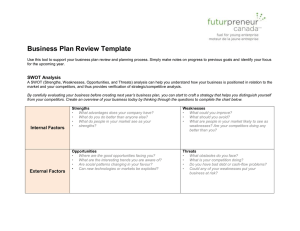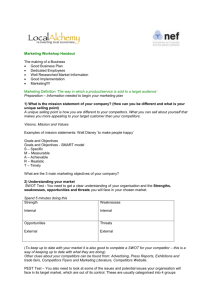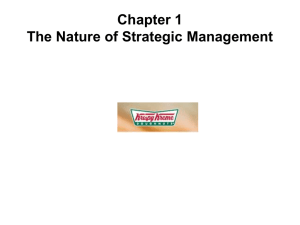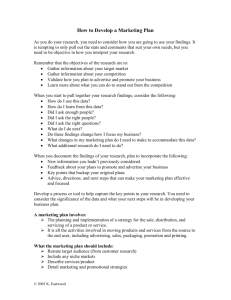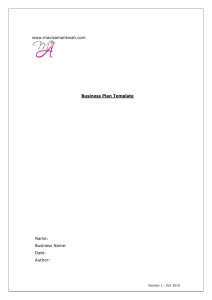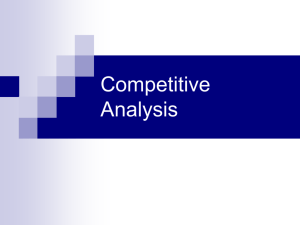Entrepreneurship I: Market & SWOT Analysis Quiz
advertisement
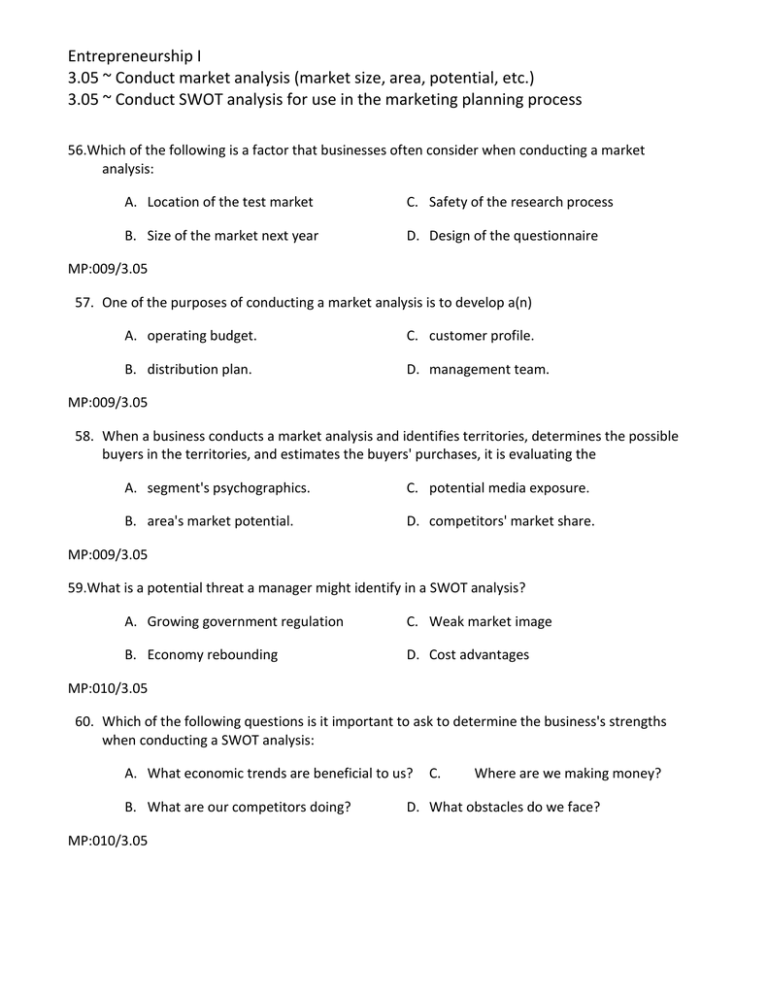
Entrepreneurship I 3.05 ~ Conduct market analysis (market size, area, potential, etc.) 3.05 ~ Conduct SWOT analysis for use in the marketing planning process 56.Which of the following is a factor that businesses often consider when conducting a market analysis: A. Location of the test market C. Safety of the research process B. Size of the market next year D. Design of the questionnaire MP:009/3.05 57. One of the purposes of conducting a market analysis is to develop a(n) A. operating budget. C. customer profile. B. distribution plan. D. management team. MP:009/3.05 58. When a business conducts a market analysis and identifies territories, determines the possible buyers in the territories, and estimates the buyers' purchases, it is evaluating the A. segment's psychographics. C. potential media exposure. B. area's market potential. D. competitors' market share. MP:009/3.05 59.What is a potential threat a manager might identify in a SWOT analysis? A. Growing government regulation C. Weak market image B. Economy rebounding D. Cost advantages MP:010/3.05 60. Which of the following questions is it important to ask to determine the business's strengths when conducting a SWOT analysis: A. What economic trends are beneficial to us? B. What are our competitors doing? MP:010/3.05 C. Where are we making money? D. What obstacles do we face? Entrepreneurship I 3.05 ~ Conduct market analysis (market size, area, potential, etc.) 3.05 ~ Conduct SWOT analysis for use in the marketing planning process 61. Which of the following is a question that a business might ask when it wants to evaluate its weaknesses: A. What resources do we lack? missed? C. What markets have our competitors B. What is our competition doing? D. What are our assets? MP:010/3.05 62.One reason why it is often important for businesses to conduct a competitive analysis is to identify A. external threats. C. economic conditions. B. potential vendors. D. future employees. MP:012/3.05 63. Which of the following is an activity that a business performs when conducting a competitive analysis: A. Sets productivity goals C. Calculates economic data B. Monitors rivals' marketing strategies D. Develops selling procedures MP:012/3.05 64. One way that a business can learn about its competitors' activities is by A. developing product specifications. C. reviewing secondary data. B. evaluating Intranet efficiencies. D. identifying communication barriers. MP:012/3.05 Entrepreneurship I 3.05 ~ Conduct market analysis (market size, area, potential, etc.) 3.05 ~ Conduct SWOT analysis for use in the marketing planning process KEY 56.B Size of the market next year. An important factor to consider when conducting a market analysis is the size of the market next year. Businesses need to know if the market is growing or decreasing. For example, if a business sells primarily to senior citizens, it needs to determine the size of that market next year and for several years to come in order to be prepared to meet the needs of that market. If a business's market is decreasing, it needs to know that so it can make changes and try to identify a new market. When conducting a market analysis, businesses do not consider the location of the test market, the safety of the research process, or the design of the questionnaire. SOURCE: MP:009/3.05 SOURCE: Boone, G., & Kurtz, D.L. (2009). Contemporary marketing 2009 (p. 300). Mason, OH: SouthWestern Cengage Learning. 57. C Customer profile. One reason why businesses analyze a market is to develop a customer profile, or an overview of the characteristics of the target customer. Businesses need to understand their customers in order to develop marketing strategies to attract those customers. Therefore, businesses obtain economic and demographic information about customers during a market analysis to find out who their customers are. Businesses do not conduct a market analysis to develop a distribution plan, an operating budget, or a management team. SOURCE: MP:009/3.05 SOURCE: Meyer, E.C., & Allen, K.R. (2006 ). Entrepreneurship and small business management (pp. 103, 128). New York: Glencoe/McGraw-Hill. 58. B Area's market potential. A market analysis is a study of a particular market segment. The purpose of the market analysis is to determine the level at which the market segment is willing and able to buy the business's products. One aspect of the market analysis addresses the area market potential, which is the number of potential customers and the potential sales volume for a specific area, territory, or location. Psychographics are lifestyle and personality considerations of a market segment. Competitors are the business's rivals. Media exposure refers to the amount of contact the business makes with the target market through the media (e.g., television, radio). Psychographics, competitors, and media exposure are other important considerations when evaluating the overall market potential of a market segment. SOURCE: MP:009/3.05 SOURCE: Kotler, P., & Lane, K. (2006). Marketing management (12th ed.) [pp. 130-131]. Upper Saddle River, NJ: Prentice Hall. 59. A Growing government regulation. Growing government regulation is a potential threat that a SWOT (strengths, weaknesses, opportunities, threats) analysis might identify. A cost advantage is an example of a potential strength. A rebounding economy is an example of potential opportunity. Weak market image is an example of a potential weakness. SOURCE: MP:010/3.05 SOURCE: Farese, L.S., Kimbrell, G., & Woloszyk, C.A. (2009). Marketing essentials (p. 31). Woodland Hills, CA: Glencoe/McGraw-Hill. Entrepreneurship I 3.05 ~ Conduct market analysis (market size, area, potential, etc.) 3.05 ~ Conduct SWOT analysis for use in the marketing planning process 60. C Where are we making money? A strength is any resource or capability your business has that can help you gain a competitive advantage in your industry. To discover what your business's strengths are, ask where the business is making money. If a particular location or a specific target market generates significant income, that is a strength that the business can build on to become even more successful. Businesses identify threats by asking what their competitors are doing, and what obstacles they face. Businesses identify possible opportunities by asking what economic trends are beneficial. SOURCE: MP:010/3.05 SOURCE: IM LAP 8—Analyze This! (SWOT Analysis) 61. A What resources do we lack? A SWOT analysis is a marketing tool that investigates a business's strengths, weaknesses, opportunities, and threats. Conducting a SWOT analysis helps a business determine what it is doing well and where it needs to improve. When examining the business's weaknesses, it should ask itself what resources it lacks. When a business lacks certain resources, it cannot operate efficiently, which reduces its ability to effectively compete in the marketplace. Therefore, it is important for the business to objectively look at its resource shortages and take steps to improve the situation. When the business asks a question about its competitors' activities, it is seeking information about a threat. When a business asks a question about particular markets the competitors have missed, it is examining opportunities. The assets, or things of value that a business has, are its strengths. SOURCE: MP:010/3.05 SOURCE: IM LAP 8—Analyze This! (SWOT Analysis) 62.A External threats. A threat is any unfavorable situation in the environment surrounding a business. Since competitors are rival businesses that seek to attract the same scarce customer dollars, they may be a threat to a business. Therefore, businesses need to analyze and know what their competitors are doing so they can identify possible threats. For example, more competitors entering the same market may be a threat to an existing business. Businesses do not conduct a competitive analysis to identify potential vendors, economic conditions, or future employees. SOURCE: MP:012 SOURCE: Farese, L.S., Kimbrell, G., & Woloszyk, C.A. (2006). Marketing essentials (p. 30). New York: Glencoe/McGraw-Hill. 63. B Monitors rivals' marketing strategies. A competitive analysis involves gathering information about a business's competitors. A business obtains the information by monitoring its competitors' marketing strategies—the activities the competitors use to market their products. The business may look at the competitors' products, web sites, advertisements, and other promotional literature to gather information. Then, the business can summarize and evaluate the information that it collected to determine its competitors' strengths and weaknesses in the marketplace. By knowing its competitors' strengths and weaknesses, the business can take steps to improve its market share, if necessary. A competitive analysis does not involve setting productivity goals, calculating economic data, or developing selling procedures. SOURCE: MP:012/3.05 SOURCE: Kotler, P., & Armstrong, G. (2008). Principles of marketing (12th ed.) [pp. 516-522]. Upper Saddle River, NJ: Prentice-Hall. Entrepreneurship I 3.05 ~ Conduct market analysis (market size, area, potential, etc.) 3.05 ~ Conduct SWOT analysis for use in the marketing planning process 64. C Reviewing secondary data. By learning about its competitors' markets, products, pricing, and promotional activities, a business can determine its competitors' strengths and weaknesses in the marketplace. By evaluating its competitors' strengths and weaknesses, a business can determine the ways in which it can gain market share. To obtain information about its competitors, the business can collect secondary data, which are information that has been collected for purposes other than the project at hand. Secondary information that the business might review includes its competitors' promotional materials, their products, and industry publications. An Intranet is a business's internal computer network. Because a business does not have direct access to its competitors' Intranet systems, it would be difficult for a business to obtain specific information about the ways in which its competitors' Intranet systems work. Developing product standards will not provide a business with information about a competitor's activities. Communication barriers are problems that interfere with the effective exchange of information. SOURCE: MP:012/3.05 SOURCE: Kotler, P., & Armstrong, G. (2008). Principles of marketing (12th ed.) [p. 519]. Upper Saddle River, NJ: Prentice-Hall.
